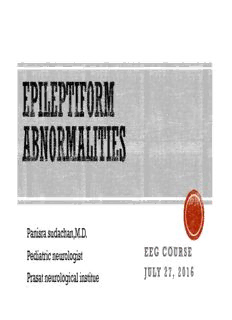
Epileptiform abnormalities PDF
Preview Epileptiform abnormalities
Panisra sudachan,M.D. E E G C O U R S E Pediatric neurologist J U LY 2 7 , 2 0 1 6 Prasat neurological institue "distinctive waves or complexes, distinguished from background activity, and resembling those recorded in a proportion of human subjects suffering from epileptic disorders…." Committee on terminology of The International Federation of Societies for Electroencephalography and Clinical Neurophysiology (IFSECN), 1974 Interictal epileptiform pattern (IED) : occur between clinical seizure Ictal epileptiform pattern : occur during clinical seizure Focal epileptiform patterns Generalized epileptiform patterns Periodic/Pseudoperiodic epileptiform patterns Sharply contoured waveforms that are distinct from the EEG background and Sharp waves usaually have a negative polarity • Sharp waves : duration shorter than 70 Spikes ms • Spikes : duration between 70 ms and 200 ms Polyspikes • Polyspikes: multiple spikes observed in rapid succession, typically at frequencies of 10 Hz orfaster,may be followed by a slow wave • Spike-and slow wave complex : the • Spike-and-slow-wave occurrence of a spike followed complex immediately by a slow wave (classically slow wave higher amplitude than spikes) • Polyspike-and-slow wave • Polyspike-and slow wave complex : complex same as SWC, but > spikes associated with one or more slow waves • varying frequency and amplitude: slow spike-and-waves (<3 Hz), 3-Hz spike-and-wave complexes and fast spike and wave (> 4Hz) Pillai J, Spering RM, Epilepsia, 47(suppl.1):14-22, 2006 • Usually asymmetry, initial half of wave (from baseline to peak) shorter duration • May followed by a slow wave • More than one phase (usually 2or3) • Out standing from background and interrupts ongoing background • Involved more than one electrode site Sharp waves Spikes Polyspikes Spike/polyspike-and-wave
Description: